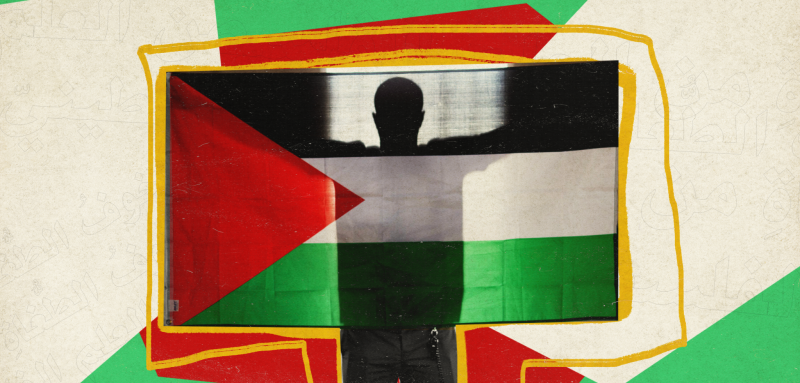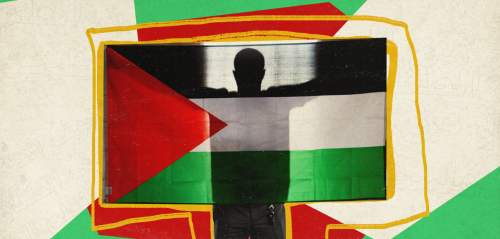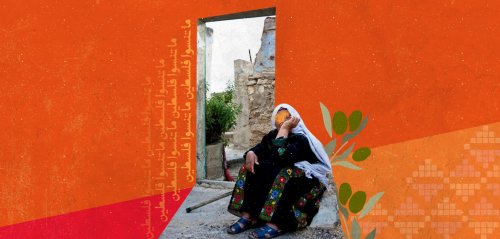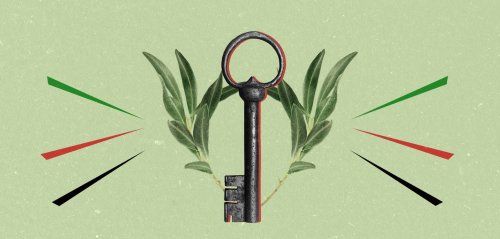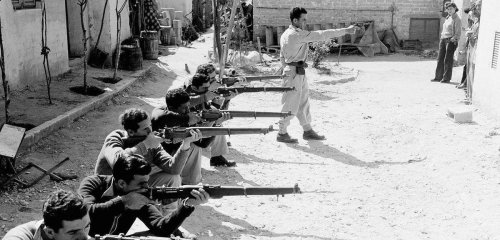In recent months, there has been a noticeable increase in the presence of the Palestinian flag, which had been highlighted through two main contexts: the intense and determined display of the flag at the Qatar World Cup, and the decision by the Israeli police to ban the raising of the Palestinian flag within the Israeli territories, under the orders of the new Minister of National Security, Kahani Itamar Ben-Gvir, in response to the celebrations that accompanied the release of the Palestinian prisoner Karim Younis.
To this day, the issue of raising the Palestinian flag in Israel remains a problematic one that the Israeli state has not yet been able to deal with adequately
This was preceded by the Israel police's aggressive insistence to prevent the flag from being raised during the funeral of slain journalist Shireen Abu Akleh, as well as a decision to ban the flag from being raised in state-funded institutions in June 2022. While the contexts for these incidents differ, they reinforce the steadfastness of Palestinians and their supporters around the world to use this flag as a tool of resistance and rejection that is unmatched by any other tool today.
Not a single person in the Arab world remained unaffected by the scenes of the Palestinian flag being raised during and after the matches, in the stands and outside them. For a moment, it seemed that the 2022 World Cup was the Palestinian World Cup.
In an interview with expert and political analyst Professor Amal Jamal, he said that the flag of Palestine in the World Cup "was a romantic act. The colors of the Palestinian flag are the colors of the entire Arab nation and it is associated with this nation." Many attributed this to the Arab audience's desire to protest the recent normalization treaties, while others believed that raising the Palestinian flag with such intensity reaffirms that the Palestinian cause remains to this day the first cause for the Arab peoples, even though it is no longer the first or central cause of many Arab regimes and their institutions.
Despite all the love and emotion for the presence of the Palestinian flag at the World Cup, this also proves that the overwhelming popular sympathy in the Arab world for the Palestinian cause has become limited to symbolic actions only
However, despite all the love, emotion, affection for the presence of the Palestinian flag at the World Cup, this also proves that the overwhelming popular sympathy in the Arab world for the Palestinian cause has become limited to symbolic gestures only, like raising the flag or writing posts on social networks. These symbolic gestures do not benefit Palestine in tangible and reliable ways. Rather, their main and most important impact – in my opinion – is limited to providing an outlet for people to express their anger and resentment about what is happening in and around Palestine. These are undoubtedly sincere and emotional practices, but they ultimately fall under acts of the "very bare minimum."
To this day, the issue of raising the Palestinian flag in Israel remains a problematic one that the Israeli state has not yet been able to deal with adequately. Immediately after the end of the 1967 setback, Israel banned the raising of the flag altogether, since it saw that it symbolized the Palestine Liberation Organization (PLO), which adopted the flag when it was founded in 1964. However, after the conclusion of the Oslo Accords, the attorney general issued a directive in 1994 to the authorities to not open a criminal case file against anyone who raises the flag, and the Israeli court confirmed this through a ruling issued the same year.
Even though the current Palestinian flag was designed by Sharif Hussein in June 1916 to be the flag of the Arab revolution against the Ottomans, it has since accumulated layers of meaning, memories and emotional charges
The raising of the Palestinian flag in the World Cup had triggered angry and disappointed reactions in Israel, both in the media and in the public. The raising of the flag was accompanied by the refusal of the overwhelming majority of Arab fans to speak to Israeli media present in Doha. In parallel with this great Israeli discontent and frustration during the World Cup, Ben-Gvir issued an order to implement the ban on raising the Palestinian flag, which comes in the context of the new approach that Ben-Gvir seeks to install, as a continuation of his recent election campaign under the slogan: "Who is the owner of the house?"
This renewed ban comes in a closely related context that cannot be separated from it: the fever of raising Israeli flags. There is a fundamental difference we are seeing today on the Israeli street between the two flags: the center and the right are competing between them over who raises the Israeli flag and who represents its values more deservedly. Is it the political center that includes what they call here the "Zionist left" with its historical project that began with the establishment of the state, its institutions, values and system of government? Or is it the right, with its extremist factions that seek to take the state towards a developing Judaism that dominates the democratic system declared within it?
It is as if both parties are pulling the flag from both sides, and one of the parties must surrender and give up holding onto the flag or else it will eventually be torn apart. This is the opposite of fighting the raising of the Palestinian flag: there is no place today to evoke what this flag represents and stands for, because official Israel (institutions and media) has succeeded in obscuring and concealing the mere existence of an occupation in the West Bank and the siege on the Gaza Strip, and there is no room to raise the flag within this suffocating and deadly blackout on what is happening "behind the high mountains", because the mere raising of it reminds of all this.
Even though the current Palestinian flag was designed by Sharif Hussein in June 1916 to be the flag of the Arab revolution against the Ottomans, it has since accumulated layers of meaning, memories and emotional charges. Professor Jamal says, "The Palestinian flag is an evocation of an absent existence that is comparable to Israeli domination and a closure on any possible alternative to the identity of time and place. It constitutes an authenticity that rivals the historical concept of the Israeli flag. Identification with the flag, both at the national level and at the general Arab level, is an alternative to Israeli affiliation."
When a Palestinian raises this flag, in the West Bank, Gaza, the interior, or in refugee camps and the diaspora, he/she is raising a piece of cloth full of meanings, memories and dreams that are far greater than the four colors that compose it
The Palestinian flag carries calamities and victories, and tears of sadness and joy. Sometimes we see it flying high and sometimes it is stained with the blood of Palestinians. Today, it is one of the most famous flags in the world, after it has become a symbol for all those who struggle and revolt, and fight against injustices. At the level of the Arab world, this flag has taken root as the first and brightest symbol of the city of Jerusalem and the Al-Aqsa Mosque, and it represents – for every Palestinian who sings the national anthem – a symbol of fidaa' (sacrifice) for Palestine:
"By the oath under the shade of the flag
By my land, by my people, and the fire of pain
I will live as a Fida'i (revolutionary), I will remain a Fida'i,
I will die as a Fida'i — until my country returns".
Therefore, when a Palestinian raises this flag, in the West Bank, Gaza, the interior, or in refugee camps and the diaspora, he/she is raising a piece of cloth full of meanings, memories and dreams that are far greater than the four colors that compose it.
* The views and opinions expressed in this article are those of the author’s and do not necessarily reflect the official policy or position of Raseef22
Raseef22 is a not for profit entity. Our focus is on quality journalism. Every contribution to the NasRaseef membership goes directly towards journalism production. We stand independent, not accepting corporate sponsorships, sponsored content or political funding.
Support our mission to keep Raseef22 available to all readers by clicking here!
Interested in writing with us? Check our pitch process here!
